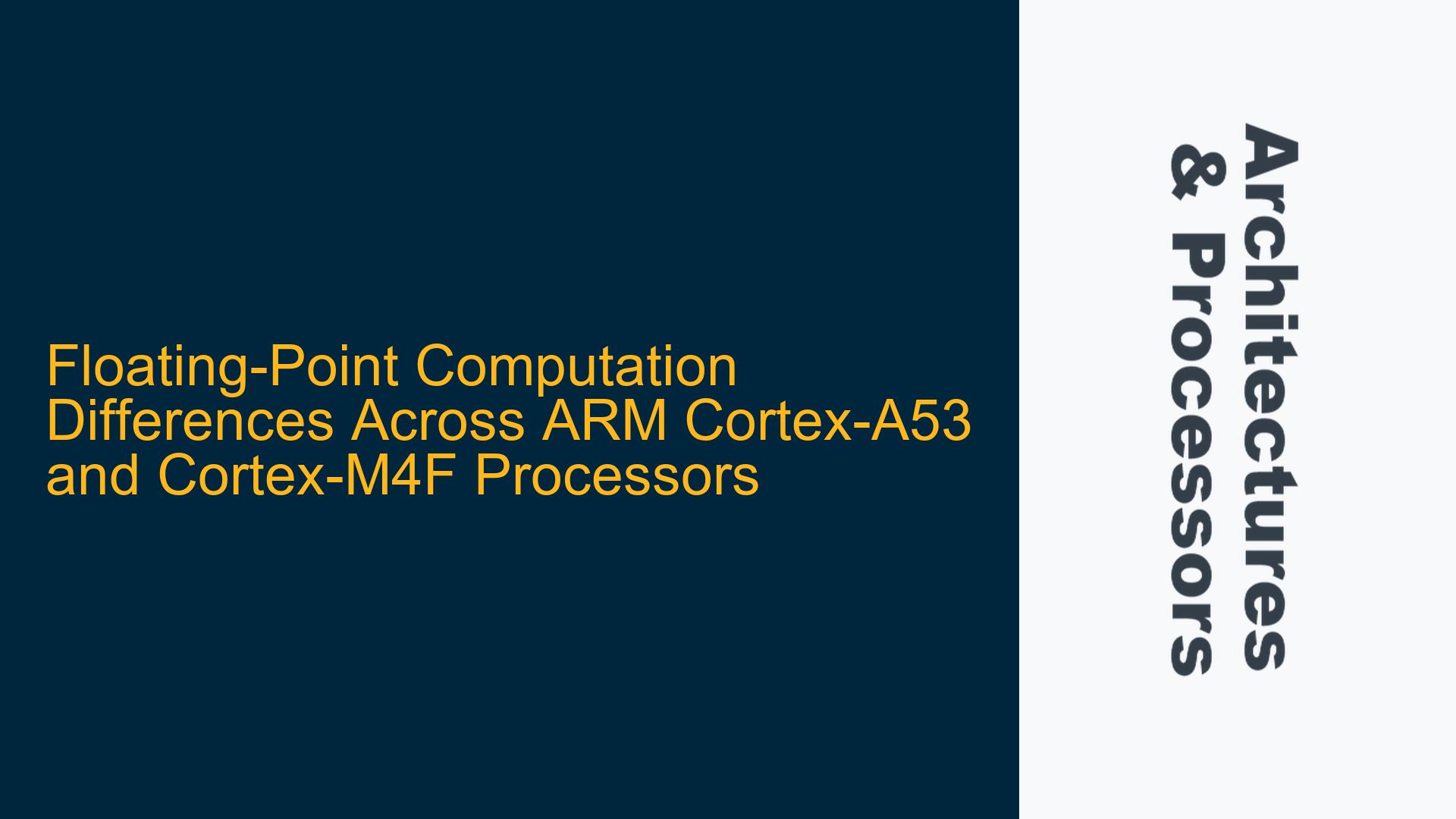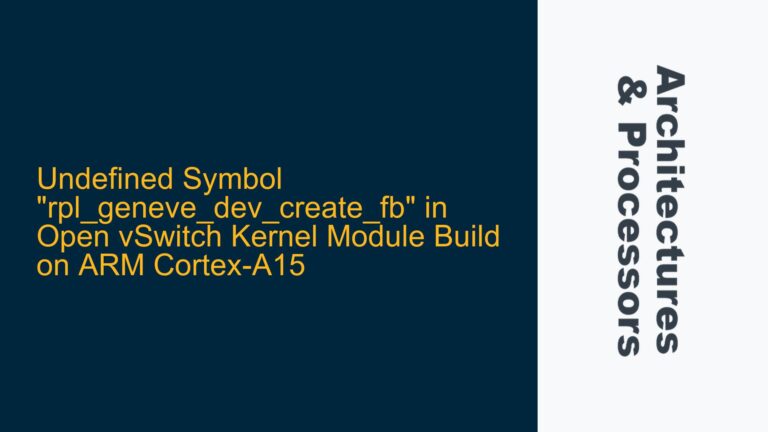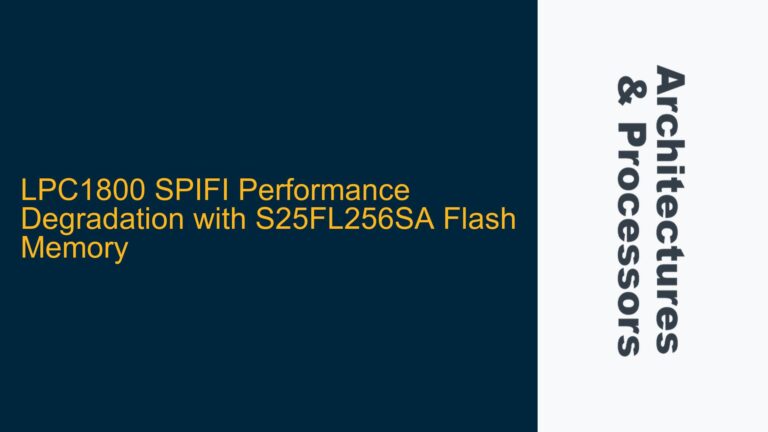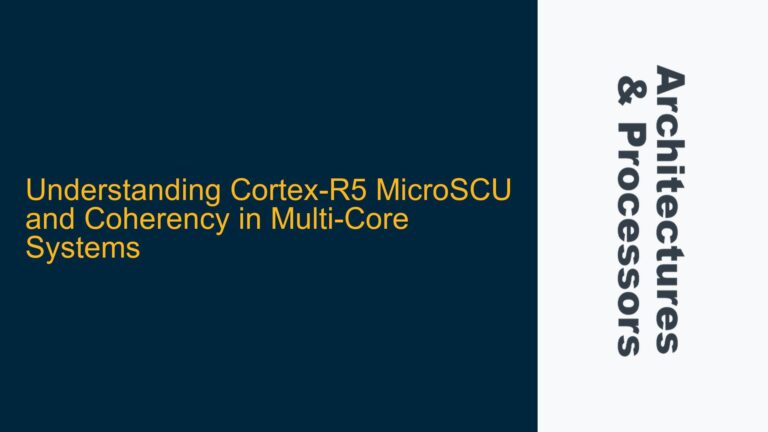Floating-Point Computation Consistency in ARM Cortex-A53 vs. Cortex-M4F
When dealing with floating-point computations in embedded systems, especially across different ARM processor families, understanding the nuances of how floating-point operations are handled is crucial. The ARM Cortex-A53 and ARM Cortex-M4F both support single-precision floating-point operations (FP32) under the IEEE 754 standard, but there are several factors that can lead to differences in the results of numerical algorithms. These differences can arise from architectural variations, compiler optimizations, and even subtle differences in the implementation of the Floating-Point Unit (FPU) across different ARM cores.
The ARM Cortex-A53 is a 64-bit processor designed for high-performance applications, often found in systems like the Raspberry Pi. It features a more complex pipeline and advanced out-of-order execution capabilities, which can affect the timing and precision of floating-point operations. On the other hand, the ARM Cortex-M4F is a 32-bit microcontroller designed for real-time embedded applications, with a simpler in-order execution pipeline and a focus on deterministic behavior. While both processors support FP32 operations, the differences in their architectures can lead to variations in how floating-point computations are executed.
One of the key considerations is the precision of intermediate results. The IEEE 754 standard allows for some flexibility in how intermediate results are handled, and different processors may choose to maintain higher precision internally before rounding to the final FP32 result. This can lead to small differences in the final output of numerical algorithms, especially in complex computations involving multiple floating-point operations.
Another factor is the handling of denormal numbers. Denormal numbers are very small numbers that cannot be represented in the standard FP32 format and are instead represented with reduced precision. Different processors may handle denormal numbers differently, either by flushing them to zero or by using specialized hardware to handle them. This can lead to differences in the results of algorithms that operate on very small numbers.
Additionally, the ARM Cortex-A53 and Cortex-M4F may have different implementations of the FPU, which can lead to differences in how certain floating-point operations are executed. For example, the Cortex-A53 may have more advanced hardware support for certain operations, such as fused multiply-add (FMA), which can affect the precision and timing of floating-point computations.
In summary, while both the ARM Cortex-A53 and Cortex-M4F support FP32 operations under the IEEE 754 standard, there are several factors that can lead to differences in the results of numerical algorithms. These differences can arise from architectural variations, compiler optimizations, and differences in the implementation of the FPU. Understanding these factors is crucial for ensuring consistent results across different ARM processors.
Architectural and Compiler-Induced Variations in Floating-Point Results
The differences in floating-point computation results between the ARM Cortex-A53 and Cortex-M4F can be attributed to several architectural and compiler-induced factors. These factors include differences in pipeline architecture, out-of-order execution, precision of intermediate results, handling of denormal numbers, and compiler optimizations.
The ARM Cortex-A53 features a more complex pipeline with out-of-order execution capabilities, which allows it to execute instructions in a non-sequential order to improve performance. This can lead to variations in the timing of floating-point operations, which can affect the precision of intermediate results. In contrast, the ARM Cortex-M4F has a simpler in-order execution pipeline, which provides more deterministic behavior but may not offer the same level of performance optimization.
The precision of intermediate results is another critical factor. The IEEE 754 standard allows for intermediate results to be maintained at a higher precision than the final FP32 result. This means that different processors may choose to maintain intermediate results at different precisions, leading to small differences in the final output of numerical algorithms. For example, the Cortex-A53 may maintain intermediate results at double precision (FP64) before rounding to FP32, while the Cortex-M4F may maintain intermediate results at FP32 precision throughout the computation.
The handling of denormal numbers can also lead to differences in floating-point results. Denormal numbers are very small numbers that cannot be represented in the standard FP32 format and are instead represented with reduced precision. Different processors may handle denormal numbers differently, either by flushing them to zero or by using specialized hardware to handle them. The Cortex-A53 may have more advanced hardware support for handling denormal numbers, while the Cortex-M4F may rely on software emulation, leading to differences in the results of algorithms that operate on very small numbers.
Compiler optimizations can also play a significant role in the differences in floating-point results. Compilers may apply different optimizations to floating-point operations, such as reordering operations or using fused multiply-add (FMA) instructions, which can affect the precision and timing of floating-point computations. The same C compiler may generate different machine code for the Cortex-A53 and Cortex-M4F, leading to differences in the results of numerical algorithms.
In summary, the differences in floating-point computation results between the ARM Cortex-A53 and Cortex-M4F can be attributed to several architectural and compiler-induced factors, including differences in pipeline architecture, precision of intermediate results, handling of denormal numbers, and compiler optimizations. Understanding these factors is crucial for ensuring consistent results across different ARM processors.
Ensuring Consistent Floating-Point Results Across ARM Processors
To ensure consistent floating-point results across different ARM processors, such as the ARM Cortex-A53 and Cortex-M4F, several steps can be taken to mitigate the differences arising from architectural variations and compiler optimizations. These steps include controlling the precision of intermediate results, managing denormal number handling, and applying consistent compiler settings.
One of the most effective ways to ensure consistent floating-point results is to control the precision of intermediate results. This can be achieved by using compiler flags or pragmas to enforce a specific precision for intermediate results. For example, the -ffloat-store flag in GCC can be used to prevent the compiler from maintaining intermediate results at a higher precision than the final FP32 result. This ensures that intermediate results are rounded to FP32 precision at each step of the computation, reducing the likelihood of differences between processors.
Another important step is to manage the handling of denormal numbers. This can be done by enabling or disabling the flush-to-zero (FTZ) and denormal-as-zero (DAZ) modes in the FPU. These modes control how denormal numbers are handled, either by flushing them to zero or by treating them as zero in computations. By enabling FTZ and DAZ modes, you can ensure that denormal numbers are handled consistently across different processors, reducing the likelihood of differences in the results of algorithms that operate on very small numbers.
Consistent compiler settings are also crucial for ensuring consistent floating-point results. This includes using the same compiler version and optimization flags across different platforms. For example, using the -O2 optimization level in GCC can provide a good balance between performance and precision, while avoiding more aggressive optimizations that may lead to differences in floating-point results. Additionally, using the -fno-fast-math flag can prevent the compiler from applying optimizations that may violate the IEEE 754 standard, such as reordering floating-point operations or using FMA instructions.
In some cases, it may be necessary to use software libraries that provide consistent floating-point behavior across different platforms. For example, the GNU Multiple Precision Arithmetic Library (GMP) and the GNU MPFR Library provide arbitrary-precision arithmetic and floating-point operations, respectively, which can be used to ensure consistent results across different processors. These libraries can be particularly useful for algorithms that require high precision or deterministic behavior.
Finally, it is important to thoroughly test and validate numerical algorithms on the target platforms to ensure consistent results. This includes running the same algorithm on both the ARM Cortex-A53 and Cortex-M4F and comparing the results to identify any differences. If differences are found, further analysis can be performed to determine the root cause and apply the appropriate mitigations.
In summary, ensuring consistent floating-point results across different ARM processors requires controlling the precision of intermediate results, managing denormal number handling, applying consistent compiler settings, using software libraries for consistent behavior, and thoroughly testing and validating numerical algorithms. By following these steps, you can mitigate the differences arising from architectural variations and compiler optimizations, ensuring consistent results across different ARM processors.






